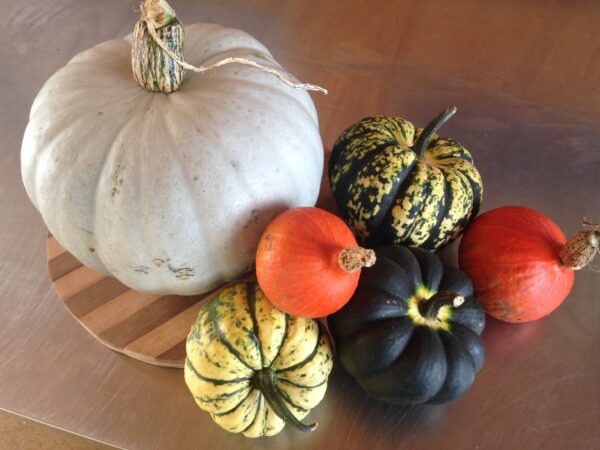
How can we not love squash?! Fascinating for their variety, diverse shape and extraordinary versatility squashes are another representative of the fruit and veg world to delight our taste buds and inspire creativity in the kitchen.
A fruit called veg
Although squashes are a kind of fruit according to its botanical classification, they are generally considered a vegetable in food preparation. Don’t let that stop you from trying them in sweet recipes though – see below! The squash family is big and it has summer and winter offsprings. The word “squash” comes from the Massachuset Tribes word askutasquash, meaning “a green thing eaten raw”, which applies to most summer squash varieties like courgettes, cucumbers, marrows and patty pans. Winter squashes though have both tougher flesh and skin and need cooking.
Know your squash
- They are high in vitamins A and C, iron and betacarotene (supports good vision and immune system)
- When selecting, look for squash that is heavy for their size, sounds hollow when knocked and has a hard, deep coloured, blemish-free skin.
- Despite their name, winter squash is a warm-weather crop, but get their name because they can be stored through the winter.
- All winter squash skin is edible, but that doesn’t necessarily mean you want to eat it. Some squash (red onion or red kuri) has thin skin that’s tasty and tender, while others (crown prince) have a tough shell that, even cooked, offers a stringy, chewy bite we would rather avoid. It can be easier to peel after cooking sometimes – try roasting it in large segments and then peel off the skin when cooked.
- Neither winter nor summer squash is suitable for freezing, because of the high water content
Cooking your squash
Squashes can be roasted, sautéed, toasted, mashed, braised, simmered, souped, curried… We can eat them in savoury dishes or delicious puddings, muffins, pies and quiches. An endless abundance of tastes and choice!
- Roasting is probably the easiest way to prepare squash. Try sprinkling some pecans, walnuts, pumpkin or sunflower seeds into the tray 10 minutes before the end to toast and crisp up. This Squash salad with spinach is a delicious and healthy recipe.
- In the midst of winter Squash soup or Squash stew is irreplaceable as it brings all the nutrients and colourfulness to warm us up the cold and brighten up the dark days.
- Making Squash humous or Squash mash is easier than you think. It goes well with toasted bread, salads or simply use as a side.
- Many winter squash varieties are suitable for stuffing. We love our Baked Squash with rice, raisins and Brussels sprouts stuffing as much as Chestnut and Manchego stuffed squash
- The sweet flavour of squash goes well with blue cheese in a pie or pasta dish. Pappardelle with butternut and blue cheese is easy and very sophisticated recipe for pasta lovers.
- Last on the menu are the deserts! Baked squash with nuts and cinnamon, Squash cheese cake with mascarpone and roasted walnuts , Butternut squash ice cream are few of many recipe ideas where you can use squash to sweeten your life.
Squash loves
Chilli, cinnamon, nutmeg, ginger, cumin, paprika, sage, rosemary, soy sauce, onion, roasted garlic, apples, celery, grains (quinoa, barley, rice), roast chicken, grilled pork